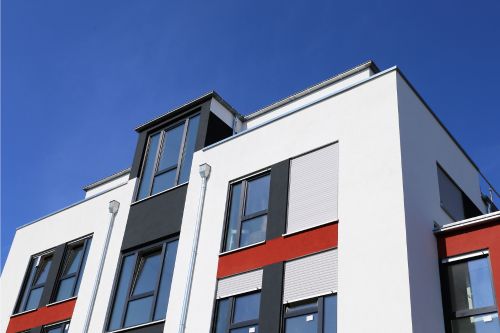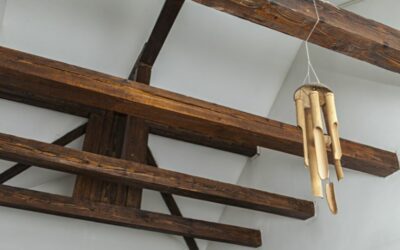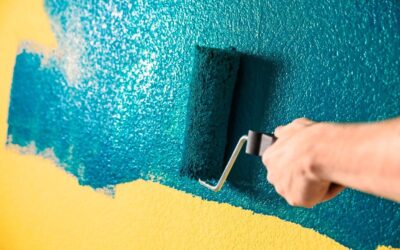The choice of colour for the facade of your home is more than just an aesthetic decision; it is a statement of your personal style and a reflection of how you want your home to be perceived. A well-chosen colour can completely transform the appearance of your home, giving it character and personality. In this guide, we’ll explore a variety of colour options and considerations to help you make the best decision for your home.
Current trends in facade colours
Neutral colours: Classic elegance
Neutral colours, such as greys, beiges and whites, are always a popular choice due to their versatility and timelessness. These shades can suit any architectural style, from modern to traditional homes, and offer great flexibility in terms of décor and colour accents. An exterior in a neutral colour can act as a calm and serene canvas, highlighting the surrounding landscape and complementing other architectural elements. In addition, neutral colours can help a home appear brighter and more spacious, which is especially beneficial for smaller properties or those in areas with little natural light.
Contact our professionals to paint your home
Bold shades: Style statement
If you’re looking for something that will make your home stand out, consider bolder, more expressive colours. Deep blues, emerald greens, or even vibrant shades of red can add a touch of boldness and personality to your home. These colours can reflect your personal style and make your home the most eye-catching on the street. However, it is important to consider the context and the neighbourhood; a very bold colour may not be well received in a community with a more conservative style. In addition, vibrant colours may require more frequent maintenance, as they tend to fade more quickly under direct sun exposure.
Key considerations when choosing colour
The environment and landscape
It is crucial to consider the environment and landscape surrounding your home when choosing a façade colour. If you live in an area with a lot of greenery and nature, you might consider colours that complement and blend in with the natural surroundings. Earth tones, soft greens or even some blues can be harmonious choices. On the other hand, in an urban or coastal environment, you may have more freedom to experiment with bolder or contrasting colours. It is also important to consider local or homeowner community regulations, as some areas have specific restrictions or guidelines on façade colours.
Architecture and style of the house
The architectural style of your home plays a key role in colour choice. Victorian-style homes, for example, may allow for a bolder and more varied colour palette, while a modern or minimalist home might benefit from more restrained, monochromatic tones. Research the history and colours traditionally associated with the style of your house. Also consider permanent elements, such as the roof, windows and doors, as these elements should harmonise with the colour you choose for the facade.
Tips for testing colours
Samples and tests on the façade
One of the best ways to make sure you are choosing the right colour for your facade is to test samples directly on the exterior wall. This allows you to see how the colour looks at different times of the day and in different light conditions. Apply samples of various colours you are considering and observe them for a few days. Pay attention to how they interact with the colours in your environment and how they change in natural light.
Digital tools and applications
Take advantage of the digital tools and paint apps available to visualise different colours in your home. Many paint brands offer apps where you can upload a photo of your home and apply different colours to the facade. This can give you a good idea of how your home would look in various shades and is a great way to experiment with different options before making a final decision.
Impact of colour on psychology and property value
Colour psychology
The colour you choose for the façade of your home can have a significant impact on your mood and that of your viewers. Colours such as blue and green are known for their relaxing and calming effects, while warmer tones such as red or yellow can be stimulating and welcoming. Choosing a colour that reflects the energy and atmosphere you want to create in your home is crucial. Also, consider how your chosen colour can affect the perceived size and shape of your home; for example, light colours can make a house appear larger and more spacious.
Influence on property value
The choice of exterior colour can also influence the resale value of your home. Neutral and classic colours tend to be more attractive to a wide range of potential buyers, as they offer a neutral base on which they can make their own changes. However, a home with a unique and well-coordinated exterior colour can also stand out in the real estate market, attracting buyers who are looking for something different. It is important to find a balance between your personal preferences and the overall appeal if you are considering selling your home in the future.
In conclusion, choosing the colour of your home’s facade is an exciting opportunity to express your personal style and enhance your home’s exterior appeal. Whether you prefer a classic, timeless approach or something bolder and more distinctive, the important thing is that the end result is something you can be proud of. At Bartolomé Bas Pinturas, we’re here to help you every step of the way, from the selection of the ideal colour to the final application, making sure your home looks exactly as you imagined it.
Other publications that may interest you
Eco-friendly anti-decay treatments for beams
Many of the ceilings of the villas and houses in and around Jávea have ceilings supported by wooden beams, as this is a very Mediterranean way of construction that is still used today, especially in rustic style houses, country houses and village houses. These...
Stucco: what is stucco and its advantages
Stucco is a paste composed of lime, plaster, cement, marble sand and natural pigments, which is applied on walls and ceilings as a decorative element. Stucco coats the walls giving them a luxurious, smooth and shiny texture, ideal for beautifying walls and ceilings....
Decorative wall paint; types and how to apply
Decorative painting on walls Throughout history, decorative paint has been used for centuries to embellish objects and building interiors, as well as to imitate materials whose cost was very high. Nowadays, the discovery of new synthetic paints allows the decoration...





